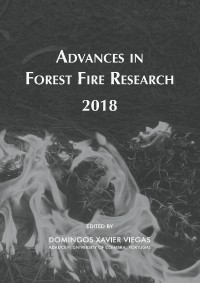Please use this identifier to cite or link to this item:
https://hdl.handle.net/10316.2/44520| DC Field | Value | Language |
|---|---|---|
| dc.contributor.author | Alves, Daniela | |
| dc.contributor.author | Ribeiro, Luís Mário | |
| dc.contributor.author | Viegas, Domingos Xavier | |
| dc.date.accessioned | 2018-11-09T11:06:15Z | |
| dc.date.accessioned | 2020-09-06T17:31:19Z | - |
| dc.date.available | 2018-11-09T11:06:15Z | |
| dc.date.available | 2020-09-06T17:31:19Z | - |
| dc.date.issued | 2018 | - |
| dc.identifier.isbn | 978-989-26-16-506 (PDF) | |
| dc.identifier.uri | https://hdl.handle.net/10316.2/44520 | - |
| dc.description.abstract | The role played by the meteorology in the development of a forest fire is widely recognized. There are several models to assess the risk of forest fires used by the authorities to define the state of readiness of the fire-fighting resources to suppress them in their early stages. The Fire Weather Index (FWI) of the Canadian Fire Danger System, widely used in several parts of the world, is a composite index that represents fire weather conditions quite well. An important aspect in the application of the FWI is the definition of the threshold values to determine the fire danger classes for a given region and day. One of the simplest methods to define the classes is to use percentiles based on historical data, but this method lacks information regarding wildfire history and its relation to FWI. To obtain a credible assessment of the fire danger using the FWI it is important to perform a calibration to determine the limiting values of FWI for each class. Probabilities of fire duration exceeding specified thresholds are then used to calibrate FWI leading to the definition of fire danger classes. Although the Canadian Fire Danger System proposes an indicative table of limiting values for the five original fire danger classes that are usually adopted, these limiting values are not universal and have to be determined for a given region and season. This study that was requested by the Joint Research Centre of Europe (JRC), aims to produce a calibration for the FWI based on historical wildfire data, for the territory of Europe, providing an updated table of threshold values to have a better definition of the risk classes of each region. The spatial division of the various countries and regions covered by the daily analysis of fire risk was defined to be the level 3 of the Nomenclature of territorial units for statistics (NUTS3). The methodology to calibrate the fire danger classes based on the statistical data of daily FWI, number of fires and burned area for each NUTS3, was performed between 2006 and 2015. | eng |
| dc.language.iso | eng | - |
| dc.publisher | Imprensa da Universidade de Coimbra | por |
| dc.relation.ispartof | http://hdl.handle.net/10316.2/44517 | por |
| dc.rights | open access | - |
| dc.subject | fire danger | eng |
| dc.subject | fire meteorology | eng |
| dc.subject | Canadian Fire Danger System | eng |
| dc.subject | Fire Weather Index | eng |
| dc.title | Calibration of the Canadian FWI system for the territory of Europe | por |
| dc.type | bookPart | por |
| uc.publication.firstPage | 33 | - |
| uc.publication.lastPage | 43 | - |
| uc.publication.location | Coimbra | por |
| dc.identifier.doi | 10.14195/978-989-26-16-506_3 | - |
| uc.publication.section | Chapter 1 - Fire Risk Management | por |
| uc.publication.digCollection | PB | por |
| uc.publication.orderno | 3 | - |
| uc.publication.area | Ciências da Engenharia e Tecnologias | por |
| uc.publication.bookTitle | Advances in forest fire research 2018 | - |
| uc.publication.manifest | https://dl.uc.pt/json/iiif/10316.2/44520/204055/manifest?manifest=/json/iiif/10316.2/44520/204055/manifest | - |
| uc.publication.thumbnail | https://dl.uc.pt/retrieve/11057374 | - |
| uc.publication.parentItemId | 55072 | - |
| uc.itemId | 68808 | - |
| item.grantfulltext | open | - |
| item.fulltext | With Fulltext | - |
| Appears in Collections: | Advances in forest fire research 2018 | |
Files in This Item:
| File | Description | Size | Format | |
|---|---|---|---|---|
| calibration_of_the_canadian_fwi_system.pdf | 1.23 MB | Adobe PDF |  |
Items in DSpace are protected by copyright, with all rights reserved, unless otherwise indicated.
